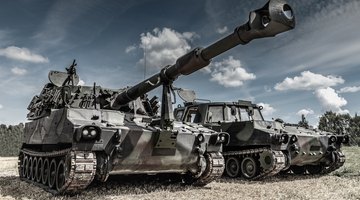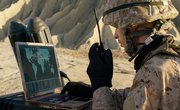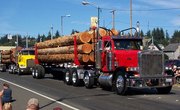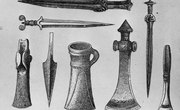Ancient and modern armies alike share the use of armor, bombardment weapons and mobile units, though thousands of years of technological advances have made their implementation far more sophisticated. Modern warfare offer new offensive and protective capabilities an ancient soldier would have marveled at. Mechanized units supplanted horses long ago, and modern elements of warfare such as airborne units simply had no analogue in ancient armies.
Armor
In the earliest days of warfare, soldiers used layers of skins and hides as protective gear, followed by wooden shields. With the dawn of the Bronze Age, metal armor came into widespread use. The Greek hoplite forces went into battle with bronze helmets, shields and breastplates, but the added protection came at a price. Helmets fit poorly and impaired vision, while the 30- to 40-pound breastplates caused troops to sweat profusely. Many would collapse from dehydration.
DuPont research chemist Stephanie Kwolek developed Kevlar in 1965, later refined into Kevlar 29 in the early 1970s. Kevlar fibers had the ability to absorb and disperse the impact of a bullet, while preventing the bullet from penetrating the Kevlar vest. Modern body armor can be categorized as soft or hard. Soft body armor consists of lightweight impact-absorbent fibers and typically acts as protection against handguns, while hard body armor uses a rigid ceramic or metal components designed to stop rifle and carbine rounds.
Bombardment Weapons
Catapults served as the first projectile bombardment weapons, dating back to ancient Greek civilization. The first catapults essentially acted as huge bows that could fire arrows up to 16 feet long. Later catapults used torsion springs that could hurl heavy projectiles at distant targets and into cities protected by walls.
Modern artillery weapons are mobile and maneuverable, while capable of unleashing tremendous firepower. The U.S. Army's Multiple Launch Rocket System can fire rockets with warheads filled with 644 M77 bomblets, which disperse in mid-air to shower the target. An MLRS launcher crew can fire their entire complement of 12 rockets within 60 seconds. Modern intercontinental ballistic missiles represent the ultimate bombardment weapon, capable of delivering conventional or nuclear payloads to any target on the globe from launch sites on land or from submarines.
Mobile Units
Chariots served as the mobile warfare units of ancient armies, employed by the Greeks, Egyptians and Chinese as platforms to unleash volleys of arrows into enemy ranks. Tanks supplanted horses as mobile warfare units by the end of World War I, and by World War II, engineers had overcome the worst of tanks' mechanical issues so that armored units became a key component of modern warfare. By the Vietnam War, the helicopter had evolved into a mobile air platform that could provide fire support for ground troops as well as ferrying them into battle. Today, armored units, mobile missile platforms and aerial units provide the support that horse-drawn units provided in ancient times.
Related Articles
References
Writer Bio
Since 2006 Jim Orrill has produced reviews and essays on popular culture for publications including Lemurvision and "Sexis." Based in Western North Carolina, Orrill graduated cum laude from the University of North Carolina with a bachelor's degree in office systems.











